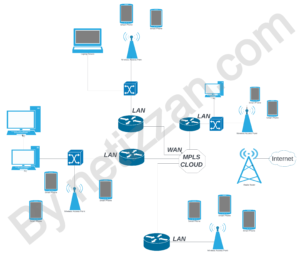To gain an understanding of Wide Area Networks (WAN) and their differences from Local Area Networks (LAN) and Metropolitan Area Networks (MAN), it is important to examine their architectural views. In this post, we will showcase a WAN architecture and show you how packets move from end-user devices through the LAN and WAN to the internet.
Wide Area Network (WAN) Overview
A Wide Area Network (WAN) serves as the connecting link between various Local Area Networks (LANs). Each LAN facilitates communication among user devices within a specific branch of an enterprise.
In contrast to Metropolitan Area networks, which cover just a region, WANs extend across cities, states, or counties, interconnecting different branches of an organization.
This is a video demonstration of what we will be covering in this article.
WAN Architecture
The architecture of a WAN involves the interconnection of various LANs using different technologies, such as Ethernet via Fiber optics or radio transmission with radio antennas. Here is a WAN architecture:

Key Components of WAN Architecture:
Here are four key components of a wide area network;
- Internet Source: The first component of WAN architecture is the internet source. The Internet source is the WAN link, which comes from the tall towers of the Internet Service Providers (ISPs) and provides internet access to a company. ISPs use provider-edge routers to connect to the internet and deliver it as WAN cable to their customers.
- MPLS Cloud: To enhance the speed and security of a WAN, Multiprotocol Label Switching (MPLS) is commonly implemented. MPLS is a packet switching technology that uses labels to make forwarding decisions.
- Customer Edge Routers: Customer Edge routers serve as gateways for each branch office (LAN) in the WAN. They facilitate local traffic forwarding between host devices within the LAN or between LANs in the WAN.
- End User Devices: The final component of the WAN architecture is the end-user devices, such as smartphones, smart TVs, and PCs, which run applications that generate network traffic. In the WAN architecture above, I included access points, but they can still be abstracted as end-user devices. Access points are just there to provide WiFi connectivity to other end-user devices.
Packet Movement in the WAN Architecture

When a user sends a packet through their application, it is forwarded to the Customer Edge router serving the specific LAN (branch). The router examines the destination IP address and determines if it belongs to a host within the LAN. If so, the router forwards it to the designated host; otherwise, it matches the packet to its WAN interface using NAT .
Once on the WAN, the packet is converted to a label using MPLS. This label contains information about the destination host and the best router to reach it. If the destination host is within the WAN, the label directs the traffic to the corresponding LAN, which forwards it to the host.
However, if the destination host is not within the WAN, the traffic traverses the internet through the ISP’s network.
Still confused about what WAN is? We have published a post on four examples of WANs and their network diagrams.
Conclusion
Understanding WAN architecture is essential for comprehending the interconnection of LANs and the flow of data packets within a Wide Area Network. Although we have abstracted some, the components we covered in this post, which include internet sources, MPLS, customer edge routers, and end-user devices, work together to facilitate seamless communication between different branches of an organization across geographical locations.

I am a passionate Networking Associate specializing in Telecommunications.
With a degree in Electronic engineering, I possess a strong understanding of electronic systems and the intricacies of telecommunications networks. I gained practical experience and valuable insights working for a prominent telecommunications company.
Additionally, I hold certifications in networking, which have solidified my expertise in network architecture, protocols, and optimization.
Through my writing skills, I aim to provide accurate and valuable knowledge in the networking field.
Connect with me on social media using the links below for more insights.
You can contact me using [email protected] or connect with me using any of the social media account linked below


